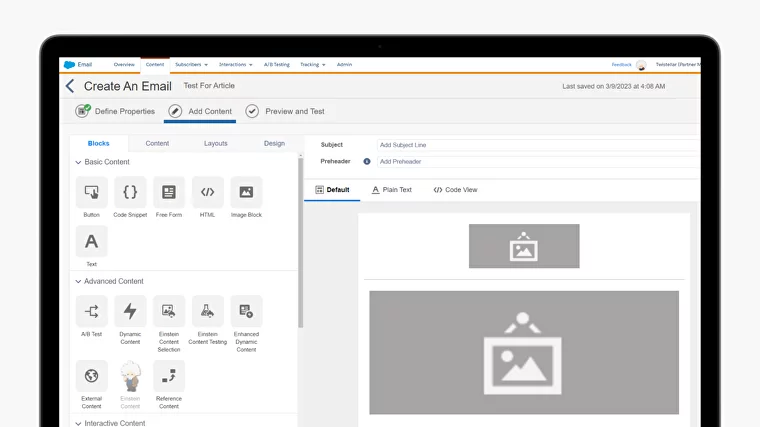Personalized Marketing Automation: Three Strategies And Examples : Twistellar
by: Twistellar
blow post content copied from Forcetalks
click here to view original post
Marketing teams do their best to create an engaging, powerful, and personalized experience for customers from their first visit to the website to make a purchase. And personalization is not an option anymore — it's a necessity.
- What do we know about the customer?
- What's the right channel and the right message?
- How to send it at the right time without spending excessive time and human resources?
However paradoxical it may sound, automation can help you create a human-like personalized experience, and answer these questions.

It can help get insights into your customer's needs with the help of AI-powered analytics and reporting.
It transforms each interaction into a personal, human-like dialogue with the help of personalized messages based on the analysis of previous customer interactions, and it automates repetitive tasks, such as email & ad campaigns, content distribution, and social media planning.
As a result, marketing operations are more optimized, and conversion rates increase.
Of course, to make automation work, you need to have consistent data and a strategy in place. Each strategy is unique to each business, and if you want to discuss how automation can help with your particular case, make sure to contact our marketing consultants.
Today our main goal is to show you some actionable tactics that we've found effective across our projects of Marketing Cloud integration and customization. We hope that you will be able to add this to your strategy as well. So, let's dive in.
Personalization Examples with Salesforce Marketing Cloud: Email
Scenario 1 — We want to send targeted personalized emails
Even though marketers can sigh sadly when they hear about email, nobody would argue with the fact that it's still one of the most popular channels of communication. 80% of our marketing automation projects are connected to improving an email strategy.
The skepticism about it is usually connected with the fact that emails are typically boring, so they end up in spam and leave you without customers, which is the basic equivalent of an unsubscribe. So how can we draw their attention to our message?

If you imagine a typical relationship with someone, knowing someone's name just makes you an acquaintance, one of many. However, if you are aware of someone's interests and can offer something based on these interests, it means that you get along well. And here it's good to mention another personalization feature that can help you build trust with your customer: dynamic content.
Dynamic Content
Dynamic content in email lets you build content blocks based on the pre-set rules that you define. It's not limited by name. Here we talk about demographic attributes, such as age, location, previous preferences, purchase data, industry, etc.
The best thing here is that you build one email that gets adapted to your audience's preferences. Just consider how much time and effort the team could save!
Imagine that you have an international e-commerce store and you want to send a personalized offer to your customer. You can choose the language of the email based on their location. You can also have different content blocks for similar products based on their previous purchases.

Personalization Examples with Salesforce Marketing Cloud: Landing Pages
Scenario 2 — We want to have adaptive landing pages

- You want to create a personalized journey based on the customers' website interactions. In our case, the company wanted to leverage its ABM strategy, as they had to hit just those accounts that were pre-defined based on size and industry.
- The information about the client's previous interactions triggered the landing pages to adapt in real-time while a customer was browsing the website, offering the most suitable services according to his history. After that, an immediate triggered notification was pushed to the sales team and a follow-up message was sent with the automatically configured content based on his latest interactions.
- Another way to leverage Personalization concerns content recommendation — if you have different products, your featured content will adapt to the topic of their interaction, highlighting those events, e-books, and posts that will inspire them to take action.
- One more good example to mention here is customer support. When you are able to track the customer history, triggered notifications to call center agents will be helpful to solve cases faster.
Personalization Examples with Salesforce Marketing Cloud: Sales Follow-Ups
Scenario 3 — We want to personalize sales follow-ups

- If a client doesn't make a purchase, an automated catch-up message is sent
- If a client doesn't make a purchase within an expected waiting period, a follow-up mail is sent offering a purchase incentive, such as discounts or special offers
- If a client makes a purchase via that email, the data is gathered and processed for further engagement
To wrap it Up
The post Personalized Marketing Automation: Three Strategies And Examples appeared first on Forcetalks.
April 11, 2023 at 04:02PM
Click here for more details...
=============================
The original post is available in Forcetalks by Twistellar
this post has been published as it is through automation. Automation script brings all the top bloggers post under a single umbrella.
The purpose of this blog, Follow the top Salesforce bloggers and collect all blogs in a single place through automation.
============================

Post a Comment